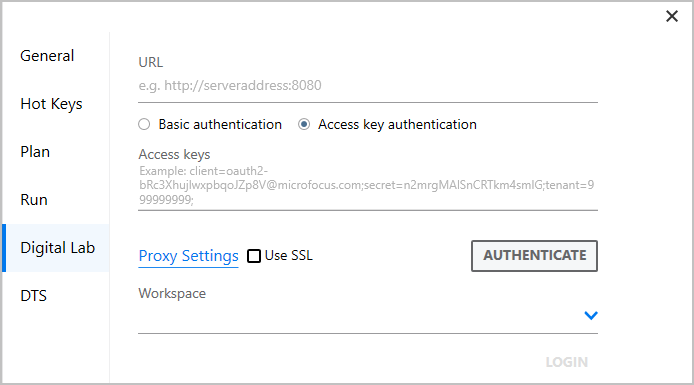Run Mobile App tests
Sprinter's integration with OpenText Functional Testing Lab (formerly UFT Mobile) lets you run your mobile app tests on a variety of devices.
You create your mobile test in Plan mode. For details, see Create a Test for mobile apps .
Connect to OpenText Functional Testing Lab
Make sure you have access to an OpenText Functional Testing Lab sever.
Upon startup, Sprinter prompts you to connect with OpenText Application Quality Management, OpenText Software Delivery Management, OpenText Functional Testing Lab, or an OpenText Functional Testing license. For details, see Log in to Sprinter.
- If you connect via OpenText Functional Testing Lab, enter the server details and credentials in the OpenText Functional Testing Lab log in area.
- If you log in OpenText Software Delivery Management or an OpenText Functional Testing license, provide the OpenText Functional Testing Lab credentials after Sprinter opens, in the Settings dialog box.
-
If you log in with OpenText Application Quality Management, then:
- If the OpenText Application Quality Management project has the OpenText Functional Testing Lab extension enabled, Sprinter automatically retrieves the OpenText Functional Testing Lab server credentials from the project. You will not be able to modify them in Sprinter.
- If the OpenText Application Quality Management project does not have the OpenText Functional Testing Lab extension enabled, Sprinter will not retrieve the credentials from the OpenText Application Quality Management Site Administration. In this case, provide the OpenText Functional Testing Lab credentials using the Settings dialog box:
-
Click Settings
 .
.
-
Choose authentication method:
- Basic authentication. Connect via a username and password.
- Access key authentication. Connect via execution access key.
- If the OpenText Functional Testing Lab server was installed with secure access (https), select Use SSL. If you did not enable this option, and the Test Connection failed, try selecting this option. When working with OpenText Functional Testing Lab through SSL, client machines must have an SSL certificate installed in the Trusted Root Certification Authorities category.
- If your connection to OpenText Functional Testing Lab is through a proxy server, click Proxy Settings to provide its details.
Run a manual mobile test
This section describes how to manually run a mobile test from Sprinter.
To run a manual mobile test:
- In Run mode, enable Power Mode and open your test.
- Click on the Application Settings button
 for Power mode.
for Power mode. -
In the Applications tab, select a mobile app from the drop down list or click Add to add a new one. The Add Application dialog box opens. Click the Mobile App icon
 . (If you logged in via OpenText Functional Testing Lab, only the Mobile App button is shown.)
. (If you logged in via OpenText Functional Testing Lab, only the Mobile App button is shown.)
- Enter a name for the application.
-
To test a native app, system app, or the home screen, click Select App. The OpenText Functional Testing Lab wizard opens. Follow the three wizard screens to select a device, app, and test options. For details, see the OpenText Functional Testing Lab wizard.
Note: If you selected the packaged version of an application for recording, you need to select the packaged version for replay.
- To test a web application, click Select Browser from the Select App dropdown. The OpenText Functional Testing Lab wizard opens. Follow the three wizard screens to select a device, browser, and device metrics. For details, see OpenText Functional Testing Lab wizard.
- Click Save and Close at the top right corner of the wizard window.
- If you are working with SAPUI5 technology in mobile applications, select SAPUI5 technology. Sprinter launches the application with the SAP OpenText Functional Testing agent in order to record all controls.
- Click Save App Settings in the Application tab.
- In the main window, open a test for execution and click the Run button. The Mobile remote view window opens with the Control Panel.
- Interact with your device and enter simulations. For information, see Create a Test for mobile apps .
-
End your test run, and proceed as you would with any other test.
Run mobile tests from OpenText Application Quality Management
This section describes how to manually run a mobile test from OpenText Application Quality Management.
To run a mobile test:
- Make sure you have enabled the OpenText Functional Testing Lab extension in OpenText Application Quality Management. For details, see Log in to Sprinter.
- Click on the OpenText Functional Testing Lab icon
 in the OpenText Application Quality Management Execution Grid or Test Instance Details dialog box. The OpenText Functional Testing Lab dialog box opens.
in the OpenText Application Quality Management Execution Grid or Test Instance Details dialog box. The OpenText Functional Testing Lab dialog box opens. - Select a test type, Mobile or Web, and click Open Wizard. Follow the wizard screens to select a device, app or browser, and device metrics. For details, see OpenText Functional Testing Lab wizard.
- Save your choices and run the test.
When you run a test, Sprinter creates an Application entry for the app used by your test, for each test instance.
 See also:
See also:










